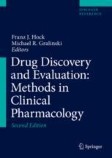Search
Search Results
-
Human variability in isoform-specific UDP-glucuronosyltransferases: markers of acute and chronic exposure, polymorphisms and uncertainty factors
UDP-glucuronosyltransferases (UGTs) are involved in phase II conjugation reactions of xenobiotics and differences in their isoform activities result...

-
Enzyme Kinetics of Uridine Diphosphate Glucuronosyltransferases (UGTs)
Glucuronidation, catalyzed by uridine diphosphate glucuronosyltransferases (UGTs), is an important process for the metabolism and clearance of many...
-

-
Human Family 1–4 cytochrome P450 enzymes involved in the metabolic activation of xenobiotic and physiological chemicals: an update
This is an overview of the metabolic activation of drugs, natural products, physiological compounds, and general chemicals by the catalytic activity...

-
Predicting the presence and mechanism of busulfan drug-drug interactions in hematopoietic stem cell transplantation using pharmacokinetic interaction network–based molecular structure similarity and network pharmacology
PurposeThis study aimed to predict the presence and mechanism of busulfan drug-drug interactions (DDIs) in hematopoietic stem cell transplantation...

-
3,3′-Diindolylmethane and indole-3-carbinol: potential therapeutic molecules for cancer chemoprevention and treatment via regulating cellular signaling pathways
Dietary compounds in cancer prevention have gained significant consideration as a viable method. Indole-3-carbinol (I3C) and 3,3′-diindolylmethane...

-
Extracellular Vesicles as Potential Therapeutic Targets and Biomarkers for Liver Disease
The accumulated evidence indicates that extracellular vesicles (EVs) play a critical role in the organs of multicellular organisms (Raposo and Stahl,...
-
Pharmacogenomics in and Its Influence on Pharmacokinetics
CYP1A2 is involved to a major extent in the metabolism of several drugs (imipramine, clozapine, fluvoxamine, olanzapine, theophylline, acetaminophen,...
-
Potent aneugenicity of 1-methylpyrene in human cells dependent on metabolic activation by endogenous enzymes
1-Methylpyrene (1-MP) is a common environmental pollutant and animal carcinogen. After sequential activation by cytochromes P450 and...

-
Enzyme Polymorphisms Affecting Xenobiotic Toxicity
Individual differences resulting from enzyme polymorphisms in gene structure and tissue-specific expression can have a significant impact to the...
-
Cardiovascular Pharmacogenomics: An Update on Clinical Studies of Antithrombotic Drugs in Brazilian Patients
Anticoagulant and antiplatelet drugs effectively prevent thrombotic events in patients with cardiovascular diseases, ischemic stroke, peripheral...

-
Xenobiotica-metabolizing enzyme induction potential of chemicals in animal studies: NanoString nCounter gene expression and peptide group-specific immunoaffinity as accelerated and economical substitutions for enzyme activity determinations?
Xenobiotica-metabolizing enzyme (XME) induction is a relevant biological/biochemical process vital to understanding the toxicological profile of...
-
Pharmacogenomics of Alzheimer’s Disease: Novel Strategies for Drug Utilization and Development
Alzheimer’s disease (AD) is a priority health problem in developed countries with a high cost to society. Approximately 20% of direct costs are...
-
Catechol-O-Methyltransferase and UDP-Glucuronosyltransferases in the Metabolism of Baicalein in Different Species
BackgroundBaicalein is the major bioactive flavonoid in some herb medicines and dietary plants; however, the detailed metabolism pathway of its major...

-
Drug Metabolism
Living systems have developed elimination mechanisms to dispose waste products and to protect themselves from exposure to potentially harmful...
-
Advanced In Vitro HepaRG Culture Systems for Xenobiotic Metabolism and Toxicity Characterization
Several HepaRG three-dimensional (3D) in vitro model systems have been developed to improve the predictability of xenobiotic metabolism and toxicity....

-
The Fusarium metabolite culmorin suppresses the in vitro glucuronidation of deoxynivalenol
Glucuronidation is a major phase II conjugation pathway in mammals, playing an important role in the detoxification and biotransformation of...

-
Co-treatment of Tuberculosis and HIV: Pharmacologic Considerations
Having HIV and TB worsens the impact of both. The treatment of HIV-TB coinfection is beset by challenges, including drug-drug-interactions,...
-
Relation of Transcriptional Factors to the Expression and Activity of Cytochrome P450 and UDP-Glucuronosyltransferases 1A in Human Liver: Co-Expression Network Analysis
Cytochrome P450 (CYPs) and UDP-glucuronosyltransferases (UGTs) play important roles in the metabolism of exogenous and endogenous compounds. The gene...

-
Pharmacogenomics in and its Influence on Pharmacokinetics
CYP1A2 is involved to a major extent in the metabolism of several drugs (imipramine, clozapine, fluvoxamine, olanzapine, theophylline, acetaminophen,...
